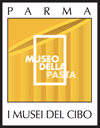The museum is located inside the Court of Giarola, in the town of Collecchio, in a farming and processing center of the medieval era. The site of a factory for tomato conserves during the first sixty years of the 1900s, today it is also in the center of the Regional Fluvial Park of the Taro.
Of Middle Eastern origins, dried pasta made of Durum wheat, found in Italy its elective homeland, and developed through the centuries in different areas of the Country: in Sicily, Liguria, in Naples, and Bologna. In the 1800s in Parma the activities of Barilla, which is today a world leader in the sector, began. The company contributed in a determining manner to the creation of the museum dedicated to pasta featuring ten sections on historical sources, the technology and culture of pasta.
The first section, dedicated to wheat, to its characteristics, and the methods of cultivation, features scale models, ancient farming tools and documents that hand down the history of the evolution of agricultural technique.
The second section is dedicated to milling, to the different types of mills, with scale models and historical iconography of great interest the reconstruction of a stone mill, and of a modern mill with cylinders.
The homemade preparation of fresh pasta, to which the third section is dedicated, is narrated through small domestic tools, the art of the rolling pin, and the extraordinary variety of the largest Italian collection of “speronelle” or pasta cutting wheels.
A real industrial pasta factory of the first half of the 1800s in the fourth section allows visitors to understand the various phases of production of dried pasta, through completely restored original machines. In the fifth section, a second nucleus of ancient machines shows the methods of production in a craft workshop of Emilia Romagna of the last century. The first continuous press produced by engineers Mario and Giuseppe Braibanti of Parma in 1933 introduces the theme of automation, developed in the sixth section of the exhibit featuring scale models and videos that present today’s extremely modern technologies employed in industrial pasta factories to constantly guarantee a high quality product over time.
The seventh section illustrates the method for shaping of over one hundred pasta formats through extruders, shaping true “architecture for the mouth”.
The eight section is dedicated to the communication of pasta with advertising boards, posters, historical “affiches” made by poster designers and graphic illustrators of great fame.
The gastronomic section presents the history of the colander, of recipe books, and the ideal combinations of formats and condiments, in order to enhance the typical dishes of the various regions of Italy and the Mediterranean Diet. An overview of pasta in Art and culture – from paintings to post stamps – closes the rich exhibit display.
THE EXHIBIT
- Il chicco gigante – The giant grain of wheat
- La botanica – Botanical science
- I cereal – Cereal
- La simbologia – Symbology
- La coltivazione – Cultivation
- La macinazione – Grinding
- I modelli dei mulini – Scale models of Mills
- Il mulino a palmenti – The water mill
- Il mulino a cilindri – The cylinder mill
- Il pane – Bread
- La pasta casalinga –Home made pasta
- La speronella – The cutting wheel
- La storia – History
- I telai di essiccazione – The drying frames
- La pasta a Parma – Pasta in Parma
- Il più antico spaghetto – The most ancient spaghetti
- Le fasi di produzione – Production phases
- Il pastificio storico del 1850 – The historical pasta factory from 1850
- La trafila – The extruder
- Il formati – Pasta formats
- Il pastificio artigianale del 1890 – The craft pasta factory from 1890
- La pressa continua Braibanti – The Braibanti continuous press
- Il modello della linea continua – The continuous production line model
- La pasta per le strade – Pasta in the streets
- La comunicazione – Communication
- Lo scolapasta – The colander
- La gastronomia – Gastronomy
- L’alimentazione – Nutrition
- La pasta nella cultura – Pasta in culture


